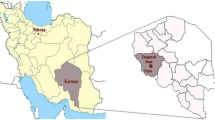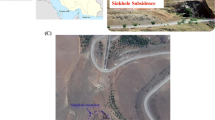Abstract
Dagangshan hydropower station is located in the middle of Dadu River, Southwest China. Many diabase dikes were exposed in the adamellite granite body during excavation of the underground caverns. The dikes are highly directional, have crushed interiors, exhibit strong alteration, and have poor contact relationships with surrounding rocks, all of which is inconsistent with the characteristics of typical diabase. This paper describes systematic research that focused on the dikes’ spatial distribution, macroscopic characteristics, physical and mechanical properties, and common instability modes. Factors influencing their stability and their corresponding control measurements are discussed in the context of the site and its conditions. Results show that most of the dikes located in the underground caverns are the branches of the main dike β9, which produced from a strong basic magma extrusion–overflow event happened in between the Permian and Triassic. Due to multiple strong tectonic activities, the chlorite alignment of these dikes generally tended to be significant and leaded the physical and mechanical properties to be poor. Then, excavation and repetitive blasts resulted in strong disturbances to the original dikes and even caused rock unloading (collapse, rock block fall) and groundwater runoff system (water inflow) change. According to the common instability modes and reasons of diabase dikes, some specific control measures including solidified rubbles, reinforcement methods, pre-grouting, and small ducts are implemented in order to keep the surrounding of diabase safety, and the results show that the control methods perform a proper effect on these engineering problems.










Similar content being viewed by others
References
Ali JR, Thompson GM, Zhou MF, Song X (2005) Emeishan large igneous province, SW China. Lithos 79(3–4):475–489
Allen CR, Luo Z, Qian H, Wen X, Zhou H, Huang W (1991) Field study of a highly active fault zone: the Xianshuihe fault of southwestern China. Geol Soc Am Bull 103(9):1178–1199
Candan O, Koralay OE, Topuz G, Oberhänsli R, Fritz H, Collins AS et al (2016) Late neoproterozoic gabbro emplacement followed by early Cambrian eclogite-facies metamorphism in the Menderes Massif (W. turkey): implications on the final assembly of gondwana. Gondwana Res 34(6):158–173
Chen KL, Wu HN, Cheng WC, Zhang Z, Chen J (2017) Geological characteristics of strata in Chongqing, China, and mitigation of the environmental impacts of tunneling-induced geo-hazards. Environ Earth Sci 76(1):10
Cui QL, Shen SL, Xu YS, Wu HN, Yin ZY (2015) Mitigation of geohazards during deep excavations in karst regions with caverns: a case study. Eng Geol 195:16–27
Dai F, Li B, Xu N et al (2016) Deformation forecasting and stability analysis of large-scale underground powerhouse caverns from microseismic monitoring. Int J Rock Mech Min Sci 86:269–281
Deng H, Wu LZ, Huang RQ, Guo XG, He Q (2016) Formation of the Siwanli ancient landslide in the Dadu River, China. Landslides 14(1):385–394
Gong M, Qi S, Liu J (2010) Engineering geological problems related to high geo-stresses at the Jinping I hydropower station, Southwest China. Bull Eng Geol Environ 69:373–380
Han Y, Chen B, Liu J, Xu J (1999) Nature and evolution of Late Paleozoic basaltic magmas along western margin of Yangtze craton: geochemical study of REE and trace elements. Diqiu Kexue Zhongguo Dizhi Daxue Xuebao/Earth Sci - J China Univ Geosci 24:234–239
Huang R (2009) Some catastrophic landslides since the twentieth century in the southwest of China. Landslides 6(1):69–81
Huang H, Yan Z (2009) Present situation and future prospect of hydropower in China. Renew Sustain Energy Rev 13:1652–1656
Ishibashi M, Yoshida H, Sasao E, Yuguchi T (2016) Long term behavior of hydrogeological structures associated with faulting: an example from the deep crystalline rock in the Mizunami URL, Central Japan. Eng Geol 208:114–127
Jin CY, Zhang CS, Feng XT (2010) Research on influence of disturbed belt on stability of surrounding rock of large-scale underground caverns. Rock Soil Mech 31:1283–1288
Li H, Zhang Z, Ernst R, Lü L, Santosh M, Zhang D et al (2015a) Giant radiating mafic dyke swarm of the Emeishan large igneous province: identifying the mantle plume centre. Terra Nova 27(4):247–257
Li SC, Zhou ZQ, Ye ZH, Li LP, Zhang QQ, Xu ZH (2015b) Comprehensive geophysical prediction and treatment measures of karst caves in deep buried tunnel. J Appl Geophys 116:247–257
Li Z, Li X, Mohammed AS, Vorkink M, Yan X (2016) A secondary sludge flow hazard induced by shallow-source seismic activity in karst mining area, Guangxi, South China: localized karstification in anticline. Nat Hazards 83(1):75–95
Lien T, Cheng C, Hwang C, Crossley D (2015) Assessing active faulting by hydrogeological modeling and superconducting gravimetry: a case study for Hsinchu Fault, Taiwan. J Geophys Res Solid Earth 119(9):7319–7335
Liu X, Liang Q, Li Z, Castillo PR, Shi Y, Xu J et al (2016) Origin of permian extremely high Ti/Y mafic lavas and dykes from Western Guangxi, SW China: implications for the Emeishan mantle plume magmatism. J Asian Earth Sci (in press) doi:10.1016/j.jseaes.2016.09.005
Ma Y, Tao Y, Zhong H et al (2009) Geochemical characteristics of the platinum-group elements in the Abulangdang ultramafic intrusion, Sichuan Province, China. Chin J Geochem 28:320–327
Margiotta S, Negri S, Parise M, Quarta TAM (2016) Karst geosites at risk of collapse: the sinkholes at Nociglia (Apulia, SE Italy). Environ Earth Sci 75(1):1–10
Qi SW, Wu FQ, Yan FZ, Lan HX (2004) Mechanism of deep cracks in the left bank slope of Jinping first stage hydropower station. Eng Geol 73(1):129–144
Qi S, Wu F, Zhou Y, Song Y, Gong M (2010) Influence of deep seated discontinuities on the left slope of Jinping I hydropower station and its stability analysis. Bull Eng Geol Environ 69(3):333–342
Rožič PŽ, Čar J, Rožič B (2016) Geological structure of the Divača area and its influence on Kačna Cave speleogenesis and hydrogeology. Acta Carsologica 44(2):153–168
Shellnutt JG (2014) The Emeishan large igneous province: a synthesis. Geosci Front 5(3):369–394
Su D, Sun A, Guo X, Wang S (2013) Seismites in the Qilianshan area of the northeastern margin of Qinghai-Tibetan Plateau and a pilot research on the regional tectonics. Acta Petrol Sin 29(6):2223–2232
Teng F, Li W, Rudnick R, Gardner L (2010) Contrasting lithium and magnesium isotope fractionation during continental weathering. Earth Planet Sci Lett 300:63–71
The National Development and Reform Committee, the People’s Republic of China (2010) Statistical bulletin of the national electric power industry-2009. Beijing, China. http://www.sdpc.gov.cn/jjxsfx/t20100713_360615.html
Vallejo LIGD (2003) Src rock mass classification of tunnels under high tectonic stress excavated in weak rocks. Eng Geol 69(3–4):273–285
Wang YL, Xiao ZS (1982) The microstructure and the behavior of the mudded shear zone in weak intercalation. Chin J Rock Mech Eng 1:37–44
Wang S, Fan C, Gang W, Wang E (2008) Late cenozoic deformation along the northwestern continuation of the Xianshuihe fault system, eastern Tibetan Plateau. Geol Soc Am Bull 120(3):S50
Wang Q, Ji S, Sun S, Marcotte D (2009) Correlations between compressional and shear wave velocities and corresponding poisson's ratios for some common rocks and sulfide ores. Tectonophysics 469(1–4):61–72
Wang Z, Li Y, Zhu W, Xue Y, Song Y (2016) Splitting failure in side walls of a large-scale underground cavern group: a numerical modelling and a field study. Springerplus 2016(5):1528
Wei X, Li Q, Li X, Niu Z (2016) Modeling the hydro-mechanical responses of sandwich structure faults during underground fluid injection. Environ Earth Sci 75(16):1155
Wu F, Hu X, Gong M, Liu J, Ren A (2010) Unloading deformation during layered excavation for the underground powerhouse of Jinping I hydropower station, Southwest China. Bull Eng Geol Env 69(3):343–351
Wu GJ, Chen WZ, Yuan JQ, Yang DS, Bian HB (2017) Formation mechanisms of water inrush and mud burst in a migmatite tunnel: a case study in China. J Mt Sci 14(1):188–195
Xia Q, Zuo R (2009) The characteristics of trace elements in Emeishan basalt and its contribution to mineralzation. Geochim Et Cosmochim Acta 73(13):A1459
Xu G, Kamp PJJ (2000) Tectonics and denudation adjacent to the Xianshuihe fault, eastern Tibetan Plateau: constraints from fission track thermochronology. J Geophys Res Atmos 105(B8):19231–19252
Xu L, Xie N (2009) Test and theoretical research on permeability characteristics of shear fracture in rock mass. Yanshilixue Yu Gongcheng Xuebao/Chin J Rock Mech Eng 28:2249–2257
Xu NW, Li TB, Dai F, Li B, Zhu YG, Yang DS (2015) Microseismic monitoring and stability evaluation for the large scale underground caverns at the Houziyan hydropower station in Southwest China. Eng Geol 188:48–67
Xu G, Li Z, Song S, Chen W, Zhang S, Dong J et al (2016) Characteristics of hydropower underground caverns engineering in China. Geol Sci Technol Inf 35(2):203–208
Zhu WS, Li XJ, Zhang QB, Zheng WH, Xin XL, Sun AH et al (2010) A study on sidewall displacement prediction and stability evaluations for large underground power station caverns. Int J Rock Mech Min Sci 47(7):1055–1062
Acknowledgements
Our researches are sponsored by Nature Science Foundation of China (NSFC) (41302228, 41472263). We take this opportunity to express our heartfelt gratitude to the committee of the foundations and sponsor of the projects. Moreover, we are thankful to the native English speaker Alanna Grandy, who work in Northern Arizona University (NAU) writing community for helping the researchers to improve the expression of academic paper.
Author information
Authors and Affiliations
Corresponding author
Rights and permissions
About this article
Cite this article
Shen, Y., Xu, G. & Yi, J. A systematic engineering geological evaluation of diabase dikes exposed at the underground caverns of Dagangshan hydropower station, Southwest China. Environ Earth Sci 76, 481 (2017). https://doi.org/10.1007/s12665-017-6806-3
Received:
Accepted:
Published:
DOI: https://doi.org/10.1007/s12665-017-6806-3




